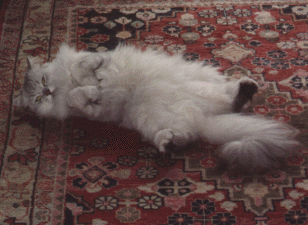
Ancient Philosophy
Professor Cynthia Freeland/Fall 1996

1. Secondary Substance: Cat (species), Animal (genus) ("Said of a subject, not in** a subject")
2. Primary Non-Substance: This white, this lying-on-its-back, this furriness (an individual which is one in number but in a non-substance category) ("In a subject, not said of a subject")
3. Secondary Non-Substance: This color, this position, this covering (a species of genus in a non-substance category) ("Both said of and in a subject")
4. Primary Substances: Fluffy, Calypso (my cat), a dog, a horse, a human (an individual substance which is a particular "this") ("Neither in nor said of a subject")
**: "In" here means:
(a) "In, not as a part" and (b) can't exist separately from what it is in.
1. Everything said of what is predicated of a subject will also be said of that subject.
Example: Animal is said of cat, which is predicated of Fluffy. So animal is also said of Fluffy (Fluffy is an animal).
2. Both the name and the differentiae of something said of a subject must be predicable of the subject.
Example: The name "cat" is said of Fluffy. If four-footed and tailed are differentiae of cat, then four-footed and tailed are also predicable of Fluffy (Fluffy is tailed and four-footed).
But this is not true of non-substances. If white is said of Fluffy, and being a light color is a differentia of white, then we ought to be able to say that Fluffy is a light color, but that's not true--Fluffy is not a color, but a cat.
3. The differentiae are not in a subject either (just as the species is not in a subject).
Example: Cat is not "in" Fluffy. White is "in" Fluffy, as a non-substance item in the category of quality. The species cat is not spoken of by Aristotle as being "in" Fluffy because it's more true "of" Fluffy, it's what must be there for Fluffy to be what he is. In the same way, four-footed is not "in" Fluffy because it is part of the very definition of what he is as a cat. Fluffy could not BE if he were not four- footed (barring accidents, of course!). However, Fluffy might have been short- haired, or blue-eyed, or black, and so those are just qualities that are "in" him.
4. a. Substances do not have a contrary. Example: There is a contrary to white, black; and to big, small; but there is no contrary to cat (we might think of "dog", but that's not really a contrary).
b. Substances do not admit of the more or the less. Something cannot be more or less of a cat. It either is or it isn't a cat. (Notice Aristotle is not thinking of kittens or of embryo cats here.)
c. Substances can receive contrary. Example: Fluffy can be (can change from) fat to thin, young to old, etc.
